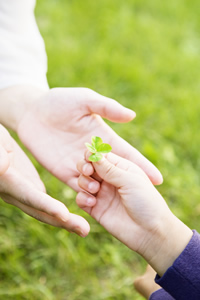The Arthritis Newsletter
Summer 2011Arthritis and Your Family
The diagnosis of arthritis may present a person with a myriad of feelings from shock, dismay, and uncertainty to frustration, anger, denial, and hopelessness. But it’s also an issue for everyone in the family!
 The diagnosis of arthritis may present a person with a myriad of feelings from shock, dismay, and uncertainty to frustration, anger, denial, and hopelessness. But it’s also an issue for everyone in the family. These feelings can also be experienced by those closest to the person with arthritis – the spouse, the children, the parents, and the siblings. It can also cause family dynamics to change dramatically. For example, researchers have found that challenges in living with arthritis may create tensions and resistance to changes in family activities, work, and leisure. For others, living with arthritis may bring a family closer together or help reshape outlooks on life.
The diagnosis of arthritis may present a person with a myriad of feelings from shock, dismay, and uncertainty to frustration, anger, denial, and hopelessness. But it’s also an issue for everyone in the family. These feelings can also be experienced by those closest to the person with arthritis – the spouse, the children, the parents, and the siblings. It can also cause family dynamics to change dramatically. For example, researchers have found that challenges in living with arthritis may create tensions and resistance to changes in family activities, work, and leisure. For others, living with arthritis may bring a family closer together or help reshape outlooks on life.
My research with couples found that the quality of spousal support was linked to the difference in perceptions of the impact of arthritis between people with rheumatoid arthritis (RA) and their spouses. We found greater support (e.g., emotional support, physical help) when couples had a shared understanding of how arthritis impacted a person with the disease. Our research also found that not only does arthritis affect family members, but family members can affect a person’s arthritis. We found that spouses’ depression predicted increased disease activity in people with RA.
The journey, as our CAB members’ families have so eloquently articulated here, is not just for the person with arthritis. It’s a journey that can capture the entire family; hence, turning one’s family upside down!
Allen J. Lehman, PhD *
Research Scientist, Arthritis Research Centre of Canada
Tim… (husband)
We were young, in love, and in the process of merging our two families when my sweetie was diagnosed with arthritis. I wasn’t too concerned. There was no arthritis in my family and I didn’t know anything about how destructive it could be. My mother-in-law had arthritis in her hands and her thumbs were bent but it didn’t slow her down or stop her from doing what she wanted to do; so I was confident that aspirin would ease the pain and we’d continue as before. But I was wrong and our lives changed.
I wasn’t much of a worrier but I became quite adept at it as arthritis medications were introduced and ultimately failed to hold the disease in check. At one point my sweetie was hospitalized for a month because her arthritis was out of control. It left me to care for our four young children, the house, meals, a full-time job and visiting hours. Chores were always shared in our home but being on my own I quickly realized just how much was involved. The days became a blur. It was surprising how much I was missing by being so busy. Making lunches late at night, waking early in the morning and getting the children off to school, reading and signing field trip authorization forms at supper time, paying the bills, and taking care of the washing and cleaning on the weekends was taking up most of my time and I wasn’t aware that the children were scared and worrying as well. Sure they asked about their mother and when she’d be coming home. I thought that because I was taking care of their needs, they were okay. I was wrong again. One Sunday morning they joined me in bed and asked what would happen if she never came back. It was an anxious and tough time for all of us.
Over the years as arthritis medications improved, so did controlling the disease, home life normalized and “Pickles” re-entered the work force. She carried on as if the disease didn’t exist anymore. Still there were many things she couldn’t do – things we did together. I often felt alone. I missed her companionship on the ski hills, at the curling rink and on the golf course. Through it all, our love for each other never waned; and as a result of it all, my sweetie became my inspiration.
MJ… (husband)
It was a pretty good year until a faceless creature – arthritis – came into our lives. My wife; vivacious, positive, and strong became paralyzed with pain in a matter of months after her diagnosis.
I can fix many things, but I could do nothing to help my wife deal with the pain and disability of arthritis. Simple things such as climbing the stairs up to bed, getting dressed, and bathing were major obstacles. I became her caregiver, and when I wasn’t with her during the day, I worried that she was facing these challenges alone. I remember feeling afraid and powerless; is this how the rest of our lives was going to play out?
Over time my fear turned to anger. Why did we not recognize the signs sooner … the extreme fatigue, the aching hands and feet, but most of all her struggle to get through the day. As I learned more about the disease, I realized we were not alone, many do not recognize the symptoms of arthritis or the devastating impact this disease can have on families.
For me, her health care team became my hope. The rheumatologist, the physical therapist, the occupational therapist, the social worker, and their staff demonstrated a genuine desire to help. As a result of her treatment (particularly biologics), she has improved and the future looks brighter. I admire my wife’s courage and optimistic attitude during the difficult times, and I have become very compassionate toward anyone whose life has been affected by arthritis.
Dee… (daughter)
I’m a pretty optimistic person, but I clearly remember when mom got diagnosed with Rheumatoid Arthritis, I thought, “Is she going to die?” I was eight or nine years old.
Of course, the diagnosis did not mean impending doom; however, it was not going to be easy – for mom, or the rest of our family.
Over the next few years, things changed. Life seemed not as simple as it once was. Before mom became ill, I think we all took advantage of her ever-present ability to do all she could for us. Once she couldn’t do that anymore, and we saw her in pain, everything had a heavier weight. I took on the motherly role, cooking and doing laundry and trying to keep our household and family together. We all tried to help her as best we could. At times I wished we could have done more. In my final year of high school, things took a turn for the worst. My mom’s arthritis was getting much worse as she tried to push through the pain. She became clinically depressed, although I didn’t know it at the time. Our family doctor helped place mom in rehabilitation at G.F. Strong in Vancouver, not for recovery from joint replacements (which did happen later in life), but because her strength and endurance had become so low she could not take care of herself. I think this was a major turning point. Once she was able to focus on her health with the right help and gentle progression, she gained not only her strength, but I think she also found her spirit once again.
Years later, while discussing mom’s diagnosis and the years that followed, mom expressed regret that she couldn’t be the mother she wanted to be for us kids. We explained that we didn’t feel that way at all. Rather, we felt that we were lucky to have such a brave mom, who we could learn real life lessons from. If it weren’t for her, and her arthritis, we wouldn’t be the people we are today.
Chris… (son)
Before the onset of Arthritis, my mom had always been an active and hardworking person. She volunteered at my school, she played tennis, she couldn’t say no when family and friends needed help, she gardened, and she took us to piano lessons, swimming lessons, dancing lessons – all this in addition to her job. Her family and friends called her “superwoman”.
When the onset of her polymyositis happened, she was hospitalized. Although I remember visiting her in the hospital, I knew my mom would recover, as she had always demonstrated such a strong will. When she returned home from the hospital, my sister and I had to assist her in getting out of bed in the morning but slowly she got stronger and was able to do this on her own. At the time, I did not realize the severity of her condition because I never saw her cry or complain about her pain, and she avoided talking about her arthritis. She also tried to hide her depression from us but I could see it in her face; when I asked her, she blamed the medications she was taking. She was careful that we didn’t feel responsible for her disease, and tried to be there for us when we needed her.
Prior to the onset of polymyositis my mom was very thin, but the medication she was taking caused her to gain a great deal of weight. When she lost the weight, I remember feeling proud, as I knew my mom was getting healthy and well. She started running and playing tennis again, and my sports activities (swimming, piano, basketball, and track and field) resumed. My mom worked hard toward her goal: REMISSION, and I am very proud of her for achieving it. She always credits her “team” at The Mary Pack Arthritis Centre for helping her beat arthritis, or as she calls arthritis “enemy number one”.
Today, my mom is an active volunteer for The Mary Pack Arthritis Society, the Vancouver Community Group, the Beta Sigma Phi Sorority Group, and she is a member of the Consumer Advisory Board for the Arthritis Research Centre of Canada. She believes in giving back – more than she received – for the benefit of others.
*Dr. Allen Lehman’s research includes:
- DO SPOUSES KNOW HOW MUCH FATIGUE, PAIN, AND PHYSICAL LIMITATION THEIR PARTNERS WITH RHEUMATOID ARTHRITIS EXPERIENCE?
- A NEW ARTHRITIS SELF-MANAGEMENT PROGRAM FOR Indigenous PEOPLE – Developed in partnership with Old Massett Village Council, Haida Gwaii
- A NEW ARTHRITIS SELF-MANAGEMENT PROGRAM FOR Indigenous PEOPLE – Developed in partnership with Kwakiutl District Council, Vancouver Island
























































